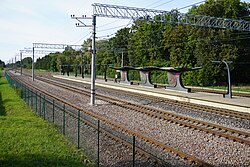Lagedi | |
|---|---|
 Lagedi railway station | |
| Coordinates: 59°24′14″N24°56′19″E / 59.40389°N 24.93861°E | |
| Country | Estonia |
| County | Harju County |
| Municipality | Rae Parish |
| Population (2022 [1] ) | |
• Total | 1,083 |
Lagedi (German : Laakt) is a small borough (Estonian : alevik) in Rae Parish, Harju County, northern Estonia. As of 2022, the settlement's population was 1,083. [1]
Lagedi has a station on the Elron's eastern route.
Lagedi was the site of a slave-labor camp during German occupation in World War II. It was a satellite camp from the Vaivara concentration camp and mass executions of Jews took place in Lagedi. [2]

